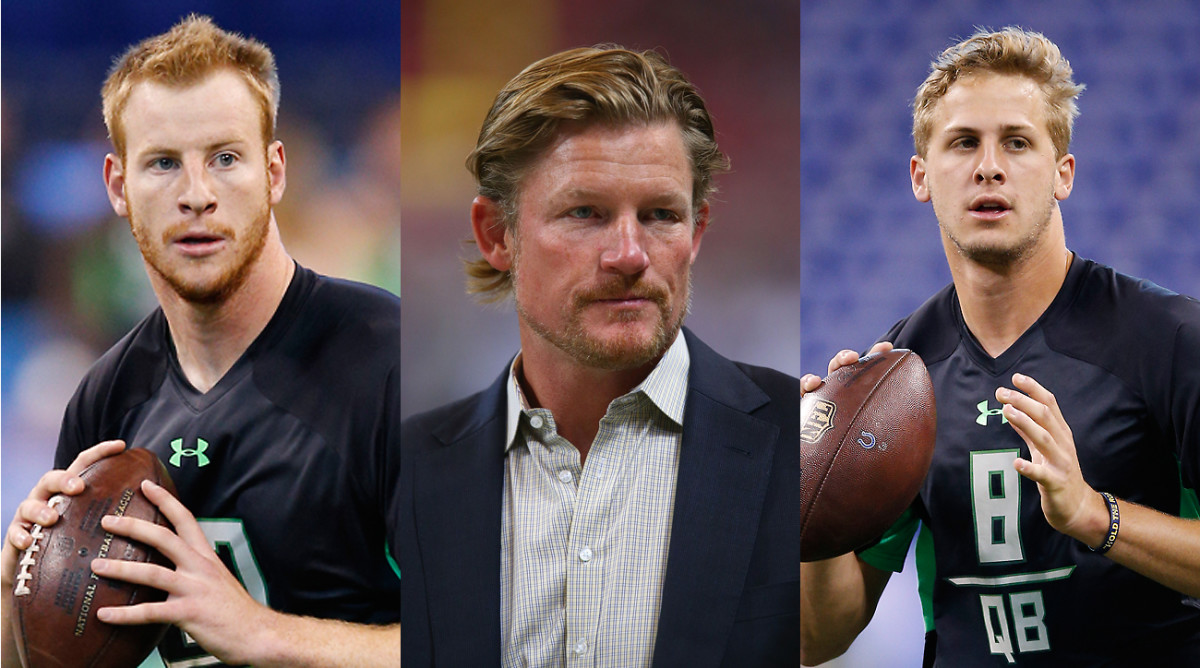The Play for No. 1: Inside the Titans-Rams Trade

Conversations between Rams GM Les Snead and his rookie Tennessee counterpart, Jon Robinson, began March 28 at the Ole Miss pro day, with Robinson there to eyeball the Titans’ presumptive top pick in the 2016 NFL draft, tackle Laremy Tunsil. Snead wanted to know what it would take for the Rams to move up from their No. 15 spot in the first round to get the first pick overall.
Robinson knew a couple of things in assessing his chance to move. He knew the Titans needed a slew of help all over the roster. And he knew Snead, who has been the boldest trader in and around draft day in his four drafts running the Rams, would do something bold. The Rams totaled an astonishing eight trades in the top 50 picks of the previous four drafts.
Talks heated up during the day Wednesday, when the Rams sent the final proposal, and when Robinson and Snead agreed on the terms of one of the biggest draft trades in NFL history: The Rams get the first pick overall in the April 28 draft, plus Tennessee’s fourth- and sixth-round picks. The Titans get the Rams’ top four picks this year (a first, two seconds and a third), plus Los Angeles’s first- and third-round picks in 2017.

The other day, one prominent GM in the league told me why he thought the Rams would move way up to pick a quarterback. He said they can’t compete in the NFC West (with Russell Wilson and Carson Palmer in place in Seattle and Arizona, respectively) without getting a quarterback. This was the text-message from this GM Thursday morning, upon hearing of the deal:
“Just like we said … Bravo, Rams.”
The upshot of the trade that radically remade the 2016 NFL draft.
• The Titans own the next two drafts. Tennessee now has six picks in the top 76 of the 2016 draft—numbers 15, 33, 43, 45, 64 and 76. With many evaluators saying the meat of this draft is between 20 and 70, Tennessee, depending on its board, could draft six players this year whom Robinson would consider starting-caliber. And the Titans set themselves up nicely for 2017—they’re the only team right now with two picks in the first round next year.
• The Rams will take a quarterback No. 1. I can tell you a final decision has not been made as to which quarterback that will be. But they obviously felt that either Carson Wentz of North Dakota State or Jared Goff of Cal was capable of being the franchise quarterback the Rams have lacked during the Jeff Fisher era. The Rams did the precise opposite of what they did in in 2012, when they traded down four spots, allowing Washington to pick Robert Griffin III number two overall and capturing four high picks in return. The Rams moved up 14 spots his year to get a quarterback.
• To a much lesser degree, the two players who’d been in play at No. 1 for Tennessee, Tunsil and cornerback Jalen Ramsey of Florida State, now muck up the very top of the draft. One or both of them could be in play beyond the top two picks—and before this trade, no one could have said that.

It’s clear why Tennessee made this trade. Very clear, in fact. Robinson saw a team that needs help on the offensive line, in the secondary and on the pass-rush, and that needs a versatile playmaking linebacker … and he thought that subtracting one single player, a franchise tackle or corner, was worth the value of getting six choices in the first three rounds of the next two drafts. Who can blame him? Smart move for Robinson and the Titans.
But the Rams, the youngest team in football over the last four seasons and a team with many defensive pieces in place, knew they’d never catch quarterback-rich Seattle or Arizona in the NFC West with Case Keenum, Nick Foles or Sean Mannion atop their quarterback depth chart. In some ways, the price was the price. It’s ridiculously exorbitant, to be sure, but without a quarterback the Rams would face another season of fighting for third in a stacked division and putting off the inevitable search for a passer.
• INSIDE THE FILM ROOM WITH JARED GOFF: Andy Benoit breaks down tape with the Cal QB
This is a league with a greater emphasis on quarterback than ever. Teams threw the ball more often last year, and for more yardage, than in any previous season in the NFL’s 96-year history. That’s why I don’t think it was especially hard for Snead and Fisher and COO Kevin Demoff to pull the trigger on this deal. Brock Osweiler, with seven career starts and a lot of question marks, just got $18 million a year in Houston. That shows how desperate teams are to get fixed at quarterback. This trade shows that the Rams believe they’re a quarterback away—and when you watch their swarming defense some Sundays, it’s hard to argue with that logic.
Why now? Why not wait to try to get a better deal and give away less value to Tennessee? I think it’s because the Rams wanted two full weeks to investigate Goff and Wentz—to find out everything they can about each guy, on and off the field. The Rams are on the clock, and they two weeks of investigative time to spare.
• Question or comment? Email us at talkback@themmqb.com.
